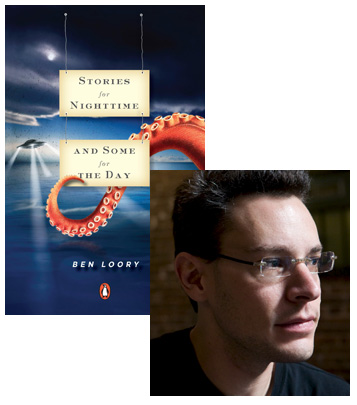Ben Loory Keeps an “Appointment in Samarra”

I’ve been dipping into Stories for Nighttime and Some for the Day, the debut story collection from Ben Loory, whenever I get a chance these last few weeks. His short-short stories are the perfect length for reading on quick subway rides, and the dazzlingly weird details ensure that each one will stand out in your mind: The one where the duck falls in love with a rock, the one where a woman becomes infuriated by the popularity of a book filled with blank pages, the one about the man who self-published his poem, the one where the man refuses to move out of a graveyard even though the dead keep trying to drag him off to some unknown fate… and dozens more like them. For his guest essay, Loory’s chosen to write about a weird story that’s become even more well-known than the novel named after it—one that’s inspired him as a reader as much as it did as a writer.
I grew up in a house filled with books. My parents were both English teachers. They’d met in graduate school, in a seminar on Milton. We didn’t have a television. Over dinner, my dad would lecture us about Joyce; my mom would counter with Virginia Woolf. I remember learning all about T.S. Eliot and the objective correlative when I was seven years old.
Of course, I wasn’t interested in books like that. I was interested in books about space. Space, and ghosts, and monsters, unsolved mysteries… and then, when I was ten, I discovered Tolkien. From there it was off in fantasy for years; I went through everything I could get my hands on. And from there I verged on into horror, then into crime, and came out one day through detective fiction. At that point (this was when I was finished with college), I made the leap from Dashiell Hammett to Ernest Hemingway. I remember thinking it was an important moment. It felt like I was growing up.
I remember finding a list one day—it wasn’t too long after that. It was the Modern Library’s list of the 100 Best English-language Novels of the Twentieth Century.
I’m going to read all of these, I said.
And so that’s what I did. I read Faulkner, Conrad, F. Scott Fitzgerald, Nabokov, D.H. Lawrence. I read Jean Rhys, Henry James, Elizabeth Bowen; I read James Joyce and Virginia Woolf. Those books led to others that weren’t on the list; I read everything by every author I liked. After each book I’d call my parents and talk to them about it. Either one of them or the other; sometimes both.
This went on for a couple years. My parents and I talked a lot about style. And I found a lot of favorites as I went—I really liked Richard Hughes’ A High Wind in Jamaica. I really liked Tobacco Road and The Magnificent Ambersons. I really liked Catch-22. I really liked Ragtime and Under the Net. I really liked A Handful of Dust.
Then one day, something happened: I picked up John O’Hara’s novel Appointment in Samarra. It was one of the few books on the Modern Library list I still had never read. I remember opening it up, ready to start, and reading the opening epigraph. It’s a single paragraph—a retelling of an ancient tale, done by W. Somerset Maugham.
31 August 2011 | selling shorts |
Read This: Becoming Ray Bradbury
 A while back, I did a review for Shelf Awareness of Becoming Ray Bradbury, a critical biography that pays close attention to Bradbury’s formative years, showing how his early love for science fiction and fantasy was tempered on the forge of literary ambition to create a distinctive voice, a steady process of refining his craft that culminates (at least in this particular analysis) with the publication of Fahrenheit 451—perhaps the one science fiction novel any random American under the age of 60 is likely to have read, thanks to generations of junior high and high school English teachers. And yet that very ubiquity can make it easy to forget that Bradbury wasn’t always quite so iconic; Jonathan Eller does an excellent job of recounting Bradbury’s long struggle for acceptance by literary lions, not just as the one science-fiction guy they could stand but as a “real” writer.
A while back, I did a review for Shelf Awareness of Becoming Ray Bradbury, a critical biography that pays close attention to Bradbury’s formative years, showing how his early love for science fiction and fantasy was tempered on the forge of literary ambition to create a distinctive voice, a steady process of refining his craft that culminates (at least in this particular analysis) with the publication of Fahrenheit 451—perhaps the one science fiction novel any random American under the age of 60 is likely to have read, thanks to generations of junior high and high school English teachers. And yet that very ubiquity can make it easy to forget that Bradbury wasn’t always quite so iconic; Jonathan Eller does an excellent job of recounting Bradbury’s long struggle for acceptance by literary lions, not just as the one science-fiction guy they could stand but as a “real” writer.
Fortuitously, Harper Perennial has just put out the paperback edition of A Pleasure to Burn, a collection of several of the stories Eller discusses—stories in which Bradbury first began to grapple with the themes of Fahrenheit 451. There are stories about book burning, and about the resistance that can be offered against it—and the resistance that can be offered against any attempt to stifle our imaginations. But there are also stories about the rise of the type of government that would believe book burning would be an acceptable form of social engineering, where walking along a sidewalk becomes a suspicious activity and contingency plans have been drawn up for the garbage trucks to collect the corpses after a nuclear war. And there are the two novellas, “Long After Midnight” and “The Fireman,” that serve as “trial runs” for the novel, both centered on the fireman Montag and his growing attraction to the forbidden books and the freedom of thought they represent. (Note: “Long After Midnight” is not the story which appeared years later in a short story collection of the same name; essentially, it’s a first draft of “The Fireman.”)
I had a great time with Eller’s biography; he’s extremely rigorous about tracking the details of Bradbury’s literary development without getting bogged down in an academic prose style. So my interest never flagged, and though I knew the rough outcome—I read Fahrenheit 451 in junior high, too—I wanted to hear all the details. And I really want the sequel that Eller ought to write, since he ends the story just as Bradbury is about to head off to Ireland to write a screenplay of Moby DIck for John Huston. That’s a story I want to hear…
27 August 2011 | read this |

 Our Endless and Proper Work is my new book with Belt Publishing about starting (and sticking to) a productive writing practice.
Our Endless and Proper Work is my new book with Belt Publishing about starting (and sticking to) a productive writing practice. 
